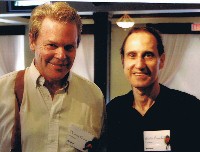|
Mastering information is critical to
companies' long-term competitiveness
Murray Conron
National Post
October 22, 2001
Lisa Colnett, chief information officer of Celestica, says the CIO's role is front and centre in her company's productivity gains.
In this competitive market, businesses depend on deploying the best information technology to support internal operations and provide services to customers. Up to about five years ago the
CIO, or chief information officer, worked under the mandate, "business rules, IT follows." The CIOs dealt with the hardware, software and IT staff to support the technology for the business and took their marching orders from the chief executive officer.
As the Internet has proved to be a technology that can boost revenue, drive cost efficiencies, reduce time-to-market and improve the total customer experience, IT has moved from supporting business strategy to driving it. Now companies focus more on the added value in the information processed. Innovations such as Web portals, virtual private networks, e-business and mobile commerce fuel the corporate engine. The CIO now participates in strategic planning with peer groups and employees.
In a tight economy with fewer market opportunities, top performance becomes more critical to meet production, sales and customer satisfaction expectations, and the link between the CIO and CEO becomes tighter.
Paul Tsaparis, CEO of Hewlett-Packard Canada, explains: "Our business unit presidents have different CIOs reporting to them. Important functions like customer relationship management (CRM) and supplier relationship management
(SRM) involve cross-functional or horizontal business relationships within our organization, so we need the input from all business units to establish the best business direction."
The CIO's role is expanding in every major corporation, as it has for Mike Reid at Toronto-based Thinkpath Inc. His firm handles IT recruiting and training for such clients as GTE, Microsoft and General Motors. Mr. Reid initially managed the company's proprietary e-recruiting software project, an Internet recruitment management system.
As Thinkpath went to market with it, Mr. Reid helped develop the business and marketing models for such clients as CIBC and Investors Group.
Mr. Reid has become the strategic custodian of Thinkpath's digital assets, which include intellectual ideas and the knowledge bank of the business processes and customers.
Lisa Colnett, CIO of Celestica, a US$10-billion global contract manufacturer of electronics and computer peripherals, has become more customer-focused by working closely with the executives in charge of each major account. Her mandate was to support Celestica's rapid expansion into global markets.
Before recent downsizing owing to market conditions, Celestica had quadrupled in size from nine plants to 42, and from 10,000 to 45,000 employees. Their customers include leaders in the IT industry (Sun, IBM, Dell, HP) and more recently, in telecommunications (Cisco and Lucent) and storage technology.
Celestica provides an Internet portal to serve its thousands of suppliers worldwide, buying annually tens of billions of dollars worth of materials and dealing with tens of thousands of part numbers. Thanks to the e-business infrastructure, their buyers and customers can place orders and have delivery commitments within hours.
"The role of CIO has been front and centre to our productivity gains," says Ms.
Colnett. "Without carefully architecting the IT solutions, we couldn't have accomplished our growth and integration plans."
Providing the infrastructure for worldwide e-commerce has been the new mandate for many
CIOs. Eugene Roman, CIO of Bell Canada, says Bell's IT staff are trained in the technological expertise and business knowledge to help move the enterprise into new areas.
"We are Web commandos," he says. "Our business is built on the Web, everything from access to content and commerce. We have 22 million customer connections, 600 interacting systems and more than 2,000 interfaces, and everything out there has to work together. Our IT challenge is, how do we innovate without taking on too much risk?"
The best CIOs look well into the future to put key people and the right technology and culture in place to steer the company for years to come. Mr. Roman adds: "Our teams build systems based on a 10-year agenda. Within that period, if a new CIO comes in, we need continuity in those business plans, not a reboot. A lot of my success will be measured not while I am in the job but after I leave it."
Charles Dunham, CIO of SAS Institute, faces similar challenges. "My objective is not to impose restraints. If we want to take on a new business venture or provide more customer service, then I make sure IT is the facilitator."
Our shift from an industrial to an information society has radically changed the functions and duties of most business roles, especially for the
CIO, who now helps to navigate the enterprise.
The role of the CIO will continue to evolve, becoming even more powerful and indispensable to a company's long-term success.
END |
